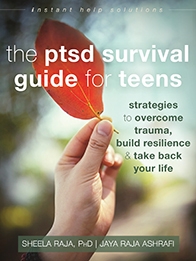By Sheela Raja, PhD, coauthor of The PTSD Survival Guide for Teens
We started summer with two high-profile celebrities dying by suicide (Anthony Bourdain and Kate Spade). All around the country, people were talking about why this happened, and what could have been done to prevent it. Around the same time, the Centers for Disease Control published a report that confirmed our fears. Suicide is now the tenth leading cause of death in the United States. On average, about 123 Americans die by suicide every day, which is a 25 percent increase in the last twenty years. This epidemic has hit our young people especially hard. In the last decade, there has been a doubling of the number of teens hospitalized for suicide risk. Sadly, teens who are struggling every day don’t make the headlines, but almost all of us know at least one young person who is really suffering. If you or someone you love is hurting, here are five ways we can start talking and start healing:
-
Trust your instincts.
If you think someone is in pain, they probably are. If someone repeatedly talks about hurting themselves or ending their lives, don’t assume that it is “just talk.” Watch out for signs, like giving away possessions, fatigue, withdrawing, and becoming isolated.
-
Understand the risks.
If you or your loved one has a history of bipolar disorder, depression, psychosis, or substance abuse, this increases the risk of suicide. If you have experienced abuse or discrimination (for example, bullying because of your weight, ethnicity, or sexual orientation) you may have also had suicidal thoughts. However, not all suicide attempts are carefully planned. Sometimes a person is at risk after a short-term stressor like a break up, doing poorly in school, or losing a job.
-
End the stigma.
Every single one of us can help end the stigma associated with mental health and stress. All of us can find small ways to talk to people we trust about what our lives are really like, both good and bad. We have to start talking openly about mental health, discrimination, bullying, and abuse. We need to see people who talk about their problems as courageous!
-
Use social media wisely.
We know that teens who use social media a lot are at a higher risk of depression. It’s tempting to compare how you feel on the inside to the “happy and successful” image that people tend to post online. Remember, that isn’t real. One of the most powerful ways we can help each other is to disconnect from our online worlds and reconnect with each other.
-
Get help.
A great resource that everyone should know about is the National Suicide Prevention Lifeline: 1-800-273-8255. Suicidal thoughts don’t last forever. If you know someone who is suffering, try to be with them, and limit their access to pills and firearms. Work with a professional; reach out to a trusted friend, family member, or teacher. Just remember that all it takes is one person to listen, one person to help you or your loved one through a difficult time.
 Sheela Raja, PhD, is a licensed clinical psychologist, and coauthor of The Sexual Trauma Workbook for Teen Girls. She is also author of Overcoming Trauma and PTSD. Raja is an associate professor at the University of Illinois at Chicago, where she researches the impact of trauma on health. Her newest book is The PTSD Survival Guide for Teens.
Sheela Raja, PhD, is a licensed clinical psychologist, and coauthor of The Sexual Trauma Workbook for Teen Girls. She is also author of Overcoming Trauma and PTSD. Raja is an associate professor at the University of Illinois at Chicago, where she researches the impact of trauma on health. Her newest book is The PTSD Survival Guide for Teens.


 2024 Peace Playbook: 3 Tactics to Avoid Clashes with Your Partner
2024 Peace Playbook: 3 Tactics to Avoid Clashes with Your Partner